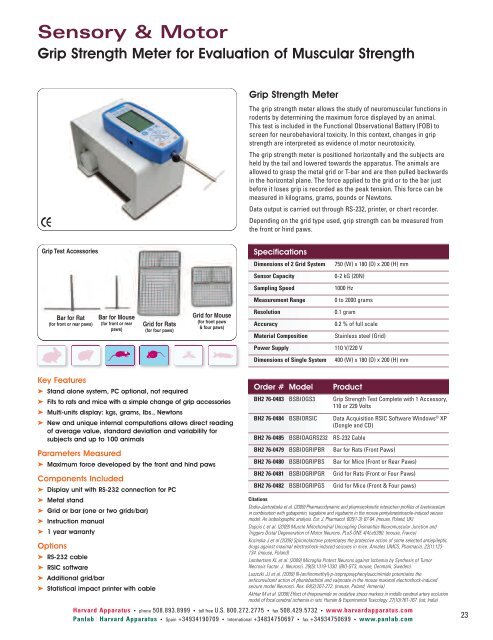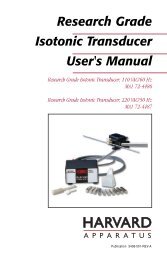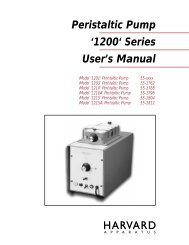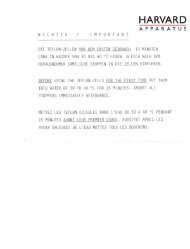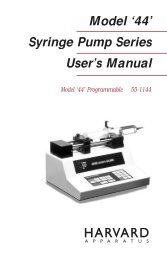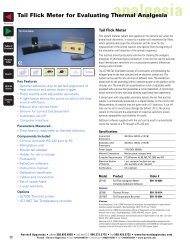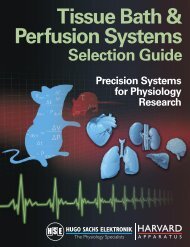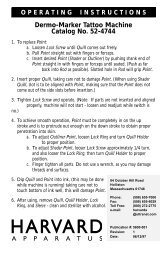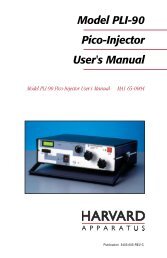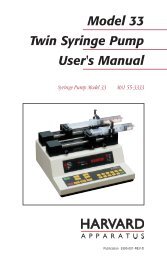View Catalog PDF - Harvard Apparatus
View Catalog PDF - Harvard Apparatus
View Catalog PDF - Harvard Apparatus
Create successful ePaper yourself
Turn your PDF publications into a flip-book with our unique Google optimized e-Paper software.
Sensory & Motor<br />
Grip Strength Meter for Evaluation of Muscular Strength<br />
Grip Strength Meter<br />
The grip strength meter allows the study of neuromuscular functions in<br />
rodents by determining the maximum force displayed by an animal.<br />
This test is included in the Functional Observational Battery (FOB) to<br />
screen for neurobehavioral toxicity. In this context, changes in grip<br />
strength are interpreted as evidence of motor neurotoxicity.<br />
The grip strength meter is positioned horizontally and the subjects are<br />
held by the tail and lowered towards the apparatus. The animals are<br />
allowed to grasp the metal grid or T-bar and are then pulled backwards<br />
in the horizontal plane. The force applied to the grid or to the bar just<br />
before it loses grip is recorded as the peak tension. This force can be<br />
measured in kilograms, grams, pounds or Newtons.<br />
Data output is carried out through RS-232, printer, or chart recorder.<br />
Depending on the grid type used, grip strength can be measured from<br />
the front or hind paws.<br />
Grip Test Accessories<br />
Specifications<br />
Dimensions of 2 Grid System<br />
750 (W) x 180 (D) x 200 (H) mm<br />
Sensor Capacity<br />
0-2 kG (20N)<br />
Sampling Speed<br />
1000 Hz<br />
Measurement Range<br />
0 to 2000 grams<br />
Bar for Rat<br />
(for front or rear paws)<br />
Bar for Mouse<br />
(for front or rear<br />
paws)<br />
Grid for Rats<br />
(for four paws)<br />
Grid for Mouse<br />
(for front paws<br />
& four paws)<br />
Resolution<br />
Accuracy<br />
Material Composition<br />
0.1 gram<br />
0.2 % of full scale<br />
Stainless steel (Grid)<br />
Power Supply<br />
110 V/220 V<br />
Dimensions of Single System<br />
400 (W) x 180 (D) x 200 (H) mm<br />
Key Features<br />
➤ Stand alone system, PC optional, not required<br />
➤ Fits to rats and mice with a simple change of grip accessories<br />
➤ Multi-units display: kgs, grams, lbs., Newtons<br />
➤ New and unique internal computations allows direct reading<br />
of average value, standard deviation and variability for<br />
subjects and up to 100 animals<br />
Parameters Measured<br />
➤ Maximum force developed by the front and hind paws<br />
Components Included<br />
➤ Display unit with RS-232 connection for PC<br />
➤ Metal stand<br />
➤ Grid or bar (one or two grids/bar)<br />
➤ Instruction manual<br />
➤ 1 year warranty<br />
Options<br />
➤ RS-232 cable<br />
➤ RSIC software<br />
➤ Additional grid/bar<br />
➤ Statistical impact printer with cable<br />
Order # Model<br />
Product<br />
BH2 76-0483 BSBIOGS3 Grip Strength Test Complete with 1 Accessory,<br />
110 or 220 Volts<br />
BH2 76-0484 BSBIORSIC Data Acquisition RSIC Software Windows ® XP<br />
(Dongle and CD)<br />
BH2 76-0485 BSBIOAGRS232 RS-232 Cable<br />
BH2 76-0479 BSBIOGRIPBR Bar for Rats (Front Paws)<br />
BH2 76-0480 BSBIOGRIPBS Bar for Mice (Front or Rear Paws)<br />
BH2 76-0481 BSBIOGRIPGR Grid for Rats (Front or Four Paws)<br />
BH2 76-0482 BSBIOGRIPGS Grid for Mice (Front & Four paws)<br />
Citations<br />
Dudra-Jastrzebska et al. (2009) Pharmacodynamic and pharmacokinetic interaction profiles of levetiracetam<br />
in combination with gabapentin, tiagabine and vigabatrin in the mouse pentylenetetrazole-induced seizure<br />
model: An isobolographic analysis. Eur. J. Pharmacol. 605(1-3): 87-94. (mouse, Poland, UK)<br />
Dupuis L et al. (2009) Muscle Mitochondrial Uncoupling Dismantles Neuromuscular Junction and<br />
Triggers Distal Degeneration of Motor Neurons. PLoS ONE 4(4):e5390. (mouse, France)<br />
Kozinska J et al (2009) Spironolactone potentiates the protective action of some selected antiepileptic<br />
drugs against maximal electroshock-induced seizures in mice. Annales UMCS, Pharmacia. 22(1):123-<br />
134. (mouse, Poland)<br />
Lambertsen KL et al. (2009) Microglia Protect Neurons against Ischemia by Synthesis of Tumor<br />
Necrosis Factor. J. Neurosci. 29(5):1319-1330. (BIO-GT3, mouse, Denmark, Sweden).<br />
Luszczki JJ et al. (2009) N-(anilinomethyl)-p-isopropoxyphenylsuccinimide potentiates the<br />
anticonvulsant action of phenobarbital and valproate in the mouse maximal electroshock-induced<br />
seizure model Neurosci. Res. 64(3):267-272. (mouse, Poland, Armenia)<br />
Akhtar M et al. (2008) Effect of thioperamide on oxidative stress markers in middle cerebral artery occlusion<br />
model of focal cerebral ischemia in rats. Human & Experimental Toxicology. 27(10):761-767. (rat, India)<br />
<strong>Harvard</strong> <strong>Apparatus</strong> • phone 508.893.8999 • toll free U.S. 800.272.2775 • fax 508.429.5732 • www.harvardapparatus.com<br />
Panlab | <strong>Harvard</strong> <strong>Apparatus</strong> • Spain +34934190709 • International +34834750697 • fax +34934750699 • www.panlab.com<br />
23


